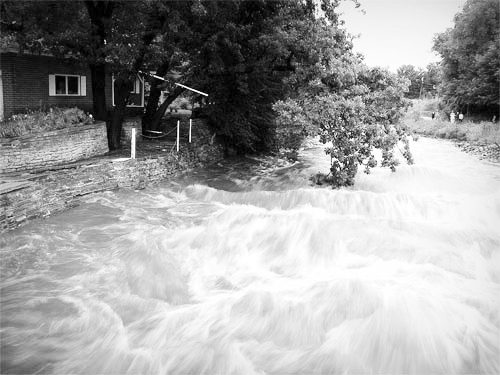Because the City of Sunny Isles Beach is located in a unique geographical area; it is particularly susceptible to flooding from major rain events and storm surge. The city is surrounded by major water bodies such as the Atlantic Ocean, and the Atlantic Ocean’s Intracoastal.
Sunny Isles Beach lies close to sea level and its underground water supply is just below the ground surface. Therefore, major rain events sometimes leave rainwater nowhere to drain, causing occasional flooding in some areas of the City. To find out if your home lies in an area susceptible to flooding, known as Special Flood Hazard Areas or flood zones, please call the Building Department at 305-947-2150. Floods are also dangerous. Even though they appear to move slowly (three feet per second), a flood two feet deep can knock a man off his feet and float a car.
Your property may be high enough that it has not been flooded during recent storms. However, it can still be flooded in the event of a worse future storm. If you are in the floodplain, the odds are that someday your property will be damaged. This flyer gives you some ideas of what you can do to protect yourself.
CITY FLOOD SERVICES:
The first thing you should do is check your flood hazard. Flood maps and flood protection references are available at the City of Sunny Isles Beach Public Library. You can also visit the Building Department on the third floor of City Hall to see if you are in a mapped floodplain. If so, they can give you more information, such as depth of flooding over a building’s first floor, past flood problems in the area, and copies of elevation certificates on buildings built in the floodplain since 1997. Even if you are not in a floodplain, there still may be some risk of flooding. If requested, both, the Public Works Department and the Building Department will visit a property to review its flood problem and explain ways to stop flooding or prevent flood damage. Call the Department at 305-947-0606. These services are free. If you are in a floodplain or have had a flood, drainage or sewer backup problem, check out these sources of assistance.
MAP DETERMINATIONS & ELEVATION CERTIFICATES:
The City of Sunny Isles Beach provides Flood Insurance Rate Map (FIRM) determinations to let you know if you are in a flood hazard area and if you are required by federal law to carry flood insurance. For surveyors, architects and engineers, the City has the latest form of elevation certificates available to you for completion. We also have a sample completed elevation certificate for your reference. For lenders, insurance agents, real estate agents, residents and businesses, elevation certificates are kept on file at the city for all buildings permitted by the city.
Call the Building Department at (305) 947- 2150 for a map determination or copy of an elevation certificate.
What You Can Do: Several of the City’s efforts depend on your cooperation and assistance. Here is how you can help:
Do not dump or throw anything into the ditches or streams. Dumping in our ditches and streams is a violation of the Miami-Dade County Code Section 15-6(2). Even grass clippings and branches can accumulate and plug channels. A plugged channel cannot carry water and when it rains the water has to go somewhere. Every piece of trash contributes to flooding. If your property is next to a ditch or stream, please do your part and keep the banks clear of brush and debris. The city has a stream maintenance program which can help remove major blockages such as downed trees.
If you see dumping or debris in the ditches or streams, contact the Public Works Department at 305-947-0606.
Always check with the Building Department before you build on, alter, re-grade, or fill on your property. A permit is needed to ensure that projects do not cause problems on other properties.
If you see building or filling without a City permit sign posted, contact the Building Dept. at 305-947-2150.
Check out the following information on flood-proofing, flood insurance and flood safety.
FLOODPROOFING:
There are several different ways to protect a building from flood damage. One way is to keep the water away by re-grading your lot or building a small floodwall or earthen berm. These methods work if your lot is large enough, if flooding is not too deep, and if your property is not in the floodway. The Building Department can provide this information.
Another approach is to make your walls waterproof and place watertight closures over the doorways. This method is not recommended for houses with basements or if water will get over two feet deep.
These measures are called flood-proofing or retrofitting. More information is available at the Sunny Isles Beach Public Library. Important note: Any alteration to your building or land requires a permit from the Building Department. Even re-grading or filling in the floodplain requires a permit.
FLOOD WARNING NOTICES
The National Weather Service monitors local weather conditions. If flooding from rain is anticipated, the Service will broadcast Flood Warning Notices through television, radio and wire services 36 hours in advance. These notices are intended to make you aware and help you prepare for possible flooding.
If an Emergency Flood Warning Notice is issued, the National Weather Service will broadcast this warning through the Emergency Broadcast System, and through TV stations such as:
• WFOR (Ch. 4),
• WTVJ (Ch. 6),
• WPLG (Ch. 10)
• Radio stations such as: WIOD (610 AM) and (940 AM)
Spanish broadcasts on TV stations:
• WSCV 51,
• WLTV 23 Radio stations:
• WCQM (1210 AM)
• WCQM (92 FM)
In the event of a natural disaster such as a hurricane, the City of Sunny Isles Beach might be required to be evacuated. Evacuation maps, and the City of Sunny Isles Beach evacuation procedures brochure, are available at City Hall (18070 Collins Avenue).
FLOOD INSURANCE:
If you know a flood is coming, you should shut off the gas and electricity and move valuable contents upstairs. It is unlikely that you will get much warning, so a detailed checklist prepared in advance would help ensure that you don’t forget anything.
If you don’t have flood insurance, talk to your insurance agent. Homeowner’s insurance policies do not cover damage from floods.
However, because Sunny Isles Beach participates in the National Flood Insurance Program, you can purchase a separate flood insurance policy. This insurance is backed by the Federal government and is available to everyone, even for properties that have been flooded.
Some people have purchased flood insurance because it was required by the bank when they got a mortgage or home improvement loan. Usually these policies just cover the building’s structure and not the contents. During the kind of flooding that happens in Sunny Isles
Beach, there is usually more damage to the furniture and contents than there is to the structure.
At last count, there were 490 flood insurance policies in Sunny Isles Beach. If you are covered, double-check that the building coverage is adequate and make sure you have contents coverage.
Remember: Even if the last flood missed you or you have done some flood-proofing, the next flood could be worse. Flood insurance covers all surface floods.
Do not wait for the next flood to buy insurance protection. There is a 30-day waiting period before National Flood Insurance Program coverage takes effect. Contact your insurance agent for more information on rates and coverage.
FLOOD SAFETY TIPS
Do not walk through flowing water.
Drowning is the number one cause of flood deaths, mostly during flash floods. Currents can be deceptive; six inches of moving water can knock you off your feet. If you walk in standing water, use a pole or stick to ensure that the ground is still there.
Do not drive through a flooded area.
More people drown in their cars than anywhere else. Don’t drive around road barriers; the road or bridge may be washed out.
Stay away from power lines and electrical wires.
The number two flood killer after drowning is electrocution.
Electrical current can travel through water.
Report downed power lines to the Power Company or city emergency management office.
Have your electricity turned off by the Power Company. Some appliances, such as television sets, keep electrical charges even after they have been unplugged. Don’t use appliances or motors that have gotten wet unless they have been taken apart, cleaned, and dried.
Look out for animals, especially snakes.
Small animals that have been flooded out of their homes may seek shelter in yours. Use a pole or stick to poke and turn things over and scare away small animals.
Look before you step.
After a flood, the ground and floors are covered with debris including broken bottles and nails. Floors and stairs that have been covered with mud can be very slippery.
Be alert for gas leaks.
Use a flashlight to inspect for damage. Don’t smoke or use candles, lanterns, or open flames unless you know the gas has been turned off and the area has been ventilated.
Evacuate:
Sunny Isles Beach is on a barrier island where, even in moderate storms, flooding from a storm surge and strong winds can be life threatening. Once Miami-Dade County gives the order to evacuate Zone B, for tropical storms or hurricanes, all residents in Sunny Isles Beach, both single and multifamily dwellings, ARE REQUIRED, BY FLORIDA LAW, TO EVACUATE. Evacuation routes include bridges and you should expect heavy traffic. To avoid traffic jams once an evacuation order is issued leave the area as soon as possible.
FLOOD PROTECTION RELATED LINKS:
Miami-Dade County Flood Protection http://www.miamidade.gov/publicworks/flooding-protection.asp
Federal Emergency Management Agency – Flooding Information http://www.fema.gov/national-flood-insurance-program
National Weather Service – National Hurricane Center http://www.nhc.noaa.gov
Miami-Dade County – Hurricane Preparedness http://www.miamidade.gov/oem/hurricaneinfo.asp






